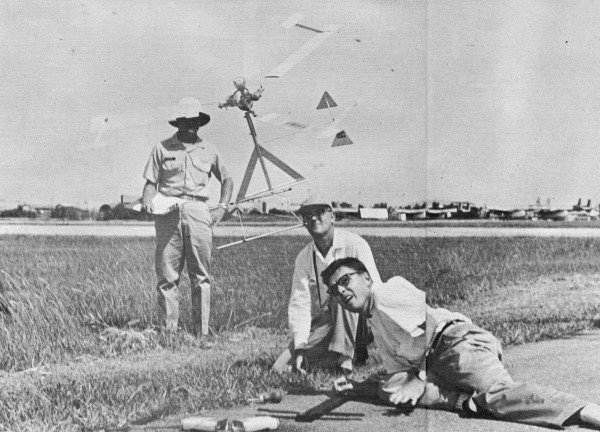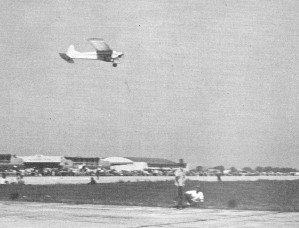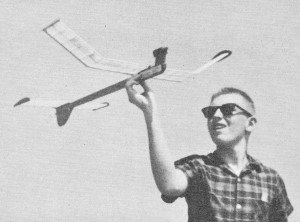|
An extensive article introducing non-modelers
to aircraft modeling appeared in the Annual Edition of the 1962 American Modeler
magazine. 15 pages were devoted to describing just about every aspect of model building
and flying - free flight gas and rubber; control line stunt, combat, scale, and
speed; helicopters and ornithopters; indoor gliders, stick and tissue, and microfilm;
even some early radio control.
In order to keep page length here reasonable (because of all the images), the
article is broken into a few pages.
Pages: | 10 &
11 | 12|
13 |
14 |
15 |16 |
17 |
18 |
19 |
20 |
21 |
22 |23 |
24 |
For Non-Modelers:
All About Air Modeling
20 Easy Ways to Go Crazy!
<next>
Long before the first man-carrying aircraft made their brief, epochal flights,
aviation's early pioneers were building miniature airplanes. Models were actually
flown successfully pre-dating the development of heavier-than-air craft.

The contraption is "diesel" engine powered helicopter.
To be more accurate, engine is "compression ignition" type.
The early experimenters utilized models in attempting to prove their theories
before building the full size craft. You can see the direct descendants of these
early experiments in many of today's models. A few notable examples are: Penaud's
rubber powered pusher airplane and helicopter (about 1874), Lilienthal's ornithopter
and gliders, the Wright brothers gliders and Langley's gas engine powered tandem-wing
model of 1896.
 WHAT'S GOING ON HERE? Well, sir,
that's a good question! Fellow above is turning round and round with his payload-lifting
endurance control line contest model.

Chap here is about to release a Jetex-powered endurance free flight (Jetex is
a tiny rocket engine, by the way).
As aviation development accelerated following the Wright Brother's 1903 flights,
the hobby of building miniature copies of the big birds followed right along. As
early as 1910 the first model airplane kits were marketed. Model clubs were formed,
exhibition flying and distance contests conducted. Rubber was the motive power and
these early bass and bamboo flyers were a far cry from today's pre-fab screamin'
demons, During the "Roaring 20's" the twin-pusher reigned supreme and if a modeler
wanted to tackle a real off-beat project he would build a five foot scale-like model
of a World War I fighter. Yards of rubber powered the brute, a modeler had to carve
his own prop and .winding it up took quite a while, but fly they did, not high or
fast, but any daylight showing under the wheels was cause for rejoicing.
Publications devoted exclusively to aviation and models commenced publication
during this period, helping to spread the word to interested airplane fans.
A new sound was heard in the land when the angry buzz of the first production
miniature gas engine turned a prop in 1932. Bill Brown's "Brown Jr." really lighted
the fuse to the dynamite! Good balsa, tough tissue and the gas engine took the ,
model out of the sandlot class and gave it true high-flying performance. Contest
flying became a popular feature; as more contests were held, class divisions and
flying rules were set up, fought over and snarled at.
During the 1930's aviation and model flying saw rapid progress and the sport
really came of age when the first National Championships ("Nats") were held.
The nation's air-mindedness moved at a fast clip from then on. Through the years
of World War.1I and into the 50's and 60's aviation's innovations stagger the imagination.
Happily, model aviation has grown right beside its big brother. "Model kit, engine
and accessory makers now serve up an amazing array of goodies that would make the
early pioneers flip.
Few hobby sports or amateur competitions offer the diversity of appeal to be
found in model aviation. There is something for every facet of interest, ability
and pocketbook. What a heritage Penaud, Lilienthal, Langley and the Wrights have
handed us! We now have R.O.G., R.O.W., FIF, C/l, RIC, jets, rockets and whirlybirds.
There are approximately three dozen different types of models flown for sport and
in contests. This number does not include the additional engine class divisions
of some particular types, such as control line speed. And the flood of plastic scale
non-fliers is not even included in this count!
With such a bountiful selection to choose from, anyone with an interest in model
aviation can easily find a special niche to suit his liking. The young beginner
is particularly fortunate in that he can find a wonderful progression from simple
to advanced high performance types.
Where to begin? Plastic scale, Ready-to-fly, kits or scratch-built, indoor, outdoor?
Rather than try to advise your choice, we present here a directory of the many types.
Models, we got 'em! No foolin' ... !
<next>
Posted December 25, 2010
|